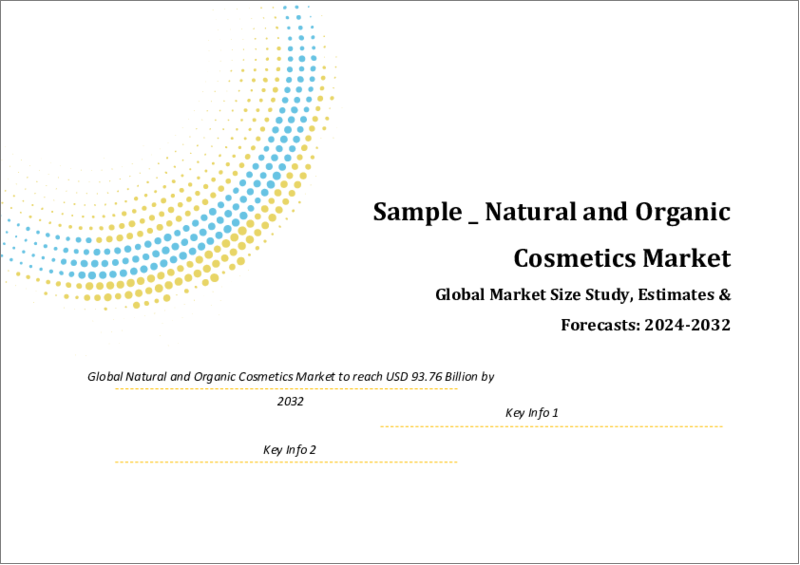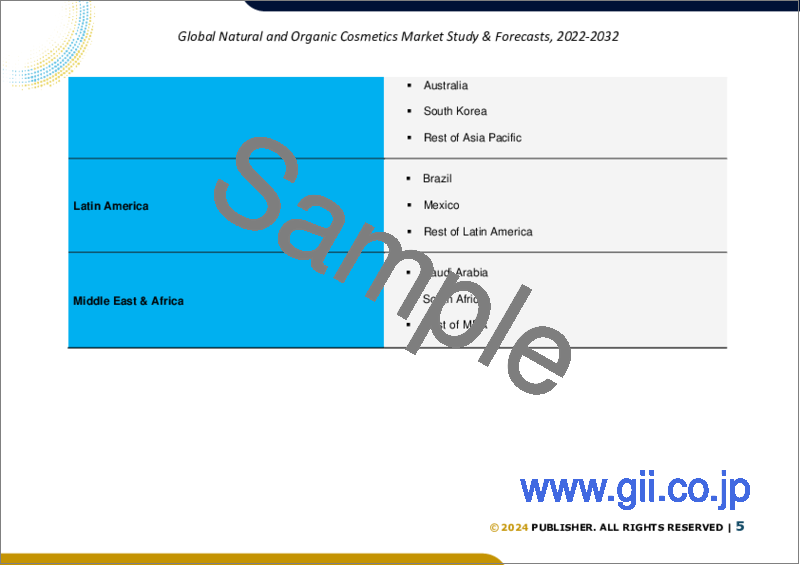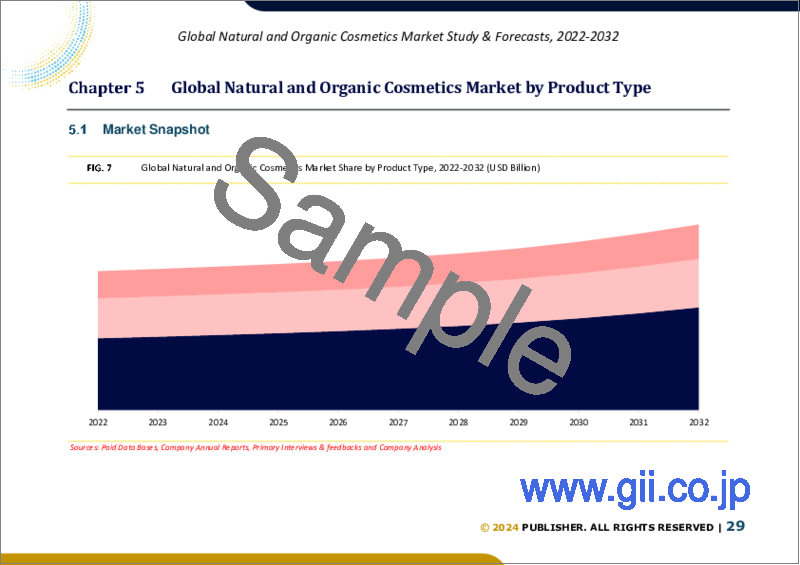|
|
市場調査レポート
商品コード
1534198
ナチュラル・オーガニック化粧品の世界市場規模調査:製品タイプ別、エンドユーザー別、流通チャネル別、地域別予測、2022年~2032年Global Natural and Organic Cosmetics Market Size study, by Product Type, by End-User, by Distribution Channel and Regional Forecasts 2022-2032 |
||||||
カスタマイズ可能
|
|||||||
| ナチュラル・オーガニック化粧品の世界市場規模調査:製品タイプ別、エンドユーザー別、流通チャネル別、地域別予測、2022年~2032年 |
|
出版日: 2024年08月10日
発行: Bizwit Research & Consulting LLP
ページ情報: 英文 285 Pages
納期: 2~3営業日
|
全表示
- 概要
- 目次
世界のナチュラル・オーガニック化粧品市場は、2023年に約414億米ドルと評価され、予測期間2024-2032年には9.51%以上の健全な成長率で成長すると予測されています。
ナチュラル・オーガニック化粧品は、合成化学物質や人工添加物を避け、自然から採取された成分から調合された製品です。ナチュラル化粧品は、植物、ミネラル、エッセンシャルオイルなど、自然界に存在する物質から抽出されるが、合成成分を含む場合もあります。オーガニック化粧品はさらに一歩進んで、合成農薬や除草剤、遺伝子組み換え作物(GMO)を使わずに栽培された原料を使用しています。どちらのタイプも、安全性と環境の持続可能性を優先しており、環境に優しいパッケージや倫理的な慣行が特徴であることが多いです。従来の化粧品に含まれる有害な化学物質に対する消費者の意識の高まりとともに、健康・衛生用品への支出が増加していることが、市場成長を促進する主な要因となっています。
ナチュラル・オーガニック化粧品市場は、急成長するeコマース産業によって力強い成長を遂げています。ソーシャルメディアの影響力の増大とインターネット普及率の上昇が、パーソナルケア製品を購入するために消費者をeコマース・プラットフォームに引き付けています。さらに、美容製品に含まれる合成成分によって誘発される肌トラブルの有病率の増加が、売上を押し上げると予想されています。メチルパラベン、プロピルパラベン、ブチルパラベンなどの合成化合物は、アレルギー反応、ニキビ、シミ、その他の肌トラブルを引き起こすことが知られています。そのため、大手企業はオーガニック製品を発売しています。例えば、2021年2月、Lady Greenはアロエベラやニームなどの天然有効成分を利用した、ニキビ肌をターゲットとしたメイクアップ製品やオーガニックフェイスケアアイテムを発表しました。
世界のナチュラル・オーガニック化粧品市場の主要地域には、北米、欧州、アジア太平洋、ラテンアメリカ、中東・アフリカが含まれます。地域的には、北米地域が2023年の市場を独占しており、消費力の向上、高級品・プレミアム製品に対する需要の増加、美容新興国市場の拡大がその要因となっています。米国が最大の市場シェアを占め、カナダは北米で最も急成長している市場です。欧州は、ライフスタイルの変化、可処分所得の増加、健康と環境に対する関心の高まりに牽引され、第2位の市場シェアを占めました。アジア太平洋地域は、消費者意識の高まりを背景に、2024年から2032年にかけて最も速いCAGRで成長すると予想されています。
目次
第1章 世界のナチュラル・オーガニック化粧品市場エグゼクティブサマリー
- ナチュラル・オーガニック化粧品の世界市場規模・予測(2022-2032年)
- 地域別概要
- セグメント別概要
- 製品タイプ別
- エンドユーザー別
- 流通チャネル別
- 主要動向
- 景気後退の影響
- アナリストの結論・提言
第2章 世界のナチュラル・オーガニック化粧品市場の定義と調査前提条件
- 調査目的
- 市場の定義
- 調査前提条件
- 包含と除外
- 制限事項
- 供給サイドの分析
- 入手可能性
- インフラ
- 規制環境
- 市場競争
- 経済性(消費者の視点)
- 需要サイド分析
- 規制の枠組み
- 技術の進歩
- 環境への配慮
- 消費者の意識と受容
- 調査手法
- 調査対象年
- 通貨換算レート
第3章 世界のナチュラル・オーガニック化粧品市場力学
- 市場促進要因
- eコマース産業の成長
- 化粧品に含まれる化学物質に対する消費者の意識の高まり
- 市場の課題
- 合成代替品の人気
- オーガニック製品のコスト上昇
- 市場機会
- 持続可能な製品に対する需要の高まり
- 有名人の支持とインフルエンサーマーケティング
第4章 世界のナチュラル・オーガニック化粧品市場産業分析
- ポーターのファイブフォースモデル
- 供給企業の交渉力
- 買い手の交渉力
- 新規参入業者の脅威
- 代替品の脅威
- 競争企業間の敵対関係
- ポーターのファイブフォースモデルへの未来的アプローチ
- ポーターのファイブフォースの影響分析
- PESTEL分析
- 政治
- 経済
- 社会
- 技術
- 環境
- 法律
- 主な投資機会
- 主要成功戦略
- 破壊的動向
- 業界専門家の視点
- アナリストの結論・提言
第5章 ナチュラル・オーガニック化粧品の世界市場規模と予測:製品タイプ別、2022年~2032年
- セグメントダッシュボード
- ナチュラル・オーガニック化粧品の世界市場:収益動向分析、2022年・2032年
- スキンケア
- ヘアケア
- オーラルケア
- メイクアップ化粧品
- その他
第6章 ナチュラル・オーガニック化粧品の世界市場規模と予測:エンドユーザー別、2022年~2032年
- セグメントダッシュボード
- ナチュラル・オーガニック化粧品の世界市場:収益動向分析、2022年・2032年
- 男性
- 女性
- ユニセックス
第7章 ナチュラル・オーガニック化粧品の世界市場規模と予測:流通チャネル別、2022年~2032年
- セグメントダッシュボード
- ナチュラル・オーガニック化粧品の世界市場:収益動向分析、2022年・2032年
- 店舗ベース
- 無店舗型
第8章 ナチュラル・オーガニック化粧品の世界市場規模と予測:地域別、2022年~2032年
- 北米
- 米国
- カナダ
- 欧州
- 英国
- ドイツ
- フランス
- スペイン
- イタリア
- その他欧州
- アジア太平洋
- 中国
- インド
- 日本
- オーストラリア
- 韓国
- その他アジア太平洋地域
- ラテンアメリカ
- ブラジル
- メキシコ
- その他ラテンアメリカ
- 中東・アフリカ
- サウジアラビア
- 南アフリカ
- その他中東とアフリカ
第9章 競合情報
- 主要企業のSWOT分析
- 主要市場戦略
- 企業プロファイル
- The Estee Lauder Companies Inc.
- 主要情報
- 概要
- 財務(データの入手可能性によります)
- 製品概要
- 市場戦略
- L'Oreal SA
- L'Occitane International SA
- FANCL Corp.
- The Clorox Co.
- Jurlique International Pty. Limited
- Laboratoire Nuxe
- Bare Escentuals, Inc.
- Aubrey Organics, Inc.
- Nature's Gate
- The Estee Lauder Companies Inc.
第10章 調査プロセス
- 調査プロセス
- データマイニング
- 分析
- 市場推定
- 検証
- 出版
- 調査属性
The Global Natural and Organic Cosmetics Market was valued at approximately USD 41.40 billion in 2023 and is anticipated to grow with a healthy growth rate of more than 9.51% over the forecast period 2024-2032. Natural and organic cosmetics are products formulated from ingredients sourced from nature, avoiding synthetic chemicals and artificial additives. Natural cosmetics are derived from naturally occurring substances, such as plants, minerals, and essential oils, but may still contain some synthetic ingredients. Organic cosmetics go a step further, using ingredients grown without synthetic pesticides, herbicides, or genetically modified organisms (GMOs). Both types prioritize safety and environmental sustainability, often featuring eco-friendly packaging and ethical practices. The increasing levels of expenditure on health and hygiene products, alongside rising consumer awareness about the harmful chemicals present in conventional cosmetics, are key market drivers enhancing market growth.
The Natural and Organic Cosmetics market is experiencing robust growth due to the burgeoning e-commerce industry. The growing impact of social media and increasing internet penetration are attracting consumers to e-commerce platforms for purchasing personal care products. Moreover, the increasing prevalence of skin problems induced by synthetic elements in beauty products is anticipated to boost sales. Synthetic compounds like methylparaben, propylparaben, and butylparaben are known to cause allergic reactions, acne, blemishes, and other skin issues. Consequently, major players are launching organic products. For instance, in February 2021, Lady Green introduced a range of makeup products and organic face care items utilizing natural active ingredients such as aloe vera and neem, targeting acne-prone skin.
The key region in the Global Natural and Organic Cosmetics Market includes North America, Europe, Asia Pacific, Latin America, Middle East & Africa. Geographically, the North American region dominated the market in 2023, driven by higher spending power, increased demand for luxury and premium products, and the growing number of beauty development stores. The US held the largest market share, while Canada was the fastest-growing market in North America. Europe accounted for the second-largest market share, driven by changing lifestyles, increasing disposable income, and growing health and environmental concerns. The Asia-Pacific region is expected to grow at the fastest CAGR from 2024 to 2032, driven by rising consumer awareness.
Major market players included in this report are:
- The Estee Lauder Companies Inc.
- L'Oreal SA
- L'Occitane International SA
- FANCL Corp.
- The Clorox Co.
- Jurlique International Pty. Limited
- Laboratoire Nuxe
- Bare Escentuals, Inc.
- Aubrey Organics, Inc.
- Nature's Gate
The detailed segments and sub-segments of the market are explained below:
By Product Type:
- Skin Care
- Hair Care
- Oral Care
- Make-Up Cosmetic
- Others
By End-User:
- Male
- Female
- Unisex
By Distribution Channel:
- Store-Based
- Non-Store-Based
By Region:
- North America
- U.S.
- Canada
- Europe
- UK
- Germany
- France
- Spain
- Italy
- ROE
- Asia Pacific
- China
- India
- Japan
- Australia
- South Korea
- RoAPAC
- Latin America
- Brazil
- Mexico
- Rest of Latin America
- Middle East & Africa
- Saudi Arabia
- South Africa
- RoMEA
Years considered for the study are as follows:
- Historical year - 2022
- Base year - 2023
- Forecast period - 2024 to 2032
Key Takeaways:
- Market Estimates & Forecast for 10 years from 2022 to 2032.
- Annualized revenues and regional level analysis for each market segment.
- Detailed analysis of geographical landscape with Country level analysis of major regions.
- Competitive landscape with information on major players in the market.
- Analysis of key business strategies and recommendations on future market approach.
- Analysis of competitive structure of the market.
- Demand side and supply side analysis of the market.
Table of Contents
Chapter 1. Global Natural and Organic Cosmetics Market Executive Summary
- 1.1. Global Natural and Organic Cosmetics Market Size & Forecast (2022-2032)
- 1.2. Regional Summary
- 1.3. Segmental Summary
- 1.3.1. By Product Type
- 1.3.2. By End-User
- 1.3.3. By Distribution Channel
- 1.4. Key Trends
- 1.5. Recession Impact
- 1.6. Analyst Recommendation & Conclusion
Chapter 2. Global Natural and Organic Cosmetics Market Definition and Research Assumptions
- 2.1. Research Objective
- 2.2. Market Definition
- 2.3. Research Assumptions
- 2.3.1. Inclusion & Exclusion
- 2.3.2. Limitations
- 2.3.3. Supply Side Analysis
- 2.3.3.1. Availability
- 2.3.3.2. Infrastructure
- 2.3.3.3. Regulatory Environment
- 2.3.3.4. Market Competition
- 2.3.3.5. Economic Viability (Consumer's Perspective)
- 2.3.4. Demand Side Analysis
- 2.3.4.1. Regulatory frameworks
- 2.3.4.2. Technological Advancements
- 2.3.4.3. Environmental Considerations
- 2.3.4.4. Consumer Awareness & Acceptance
- 2.4. Estimation Methodology
- 2.5. Years Considered for the Study
- 2.6. Currency Conversion Rates
Chapter 3. Global Natural and Organic Cosmetics Market Dynamics
- 3.1. Market Drivers
- 3.1.1. Growth of E-Commerce Industry
- 3.1.2. Increasing Consumer Awareness about Chemicals in Cosmetics
- 3.2. Market Challenges
- 3.2.1. Popularity of Synthetic Alternatives
- 3.2.2. Higher Costs of Organic Products
- 3.3. Market Opportunities
- 3.3.1. Increasing Demand for Sustainable Products
- 3.3.2. Celebrity Endorsements and Influencer Marketing
Chapter 4. Global Natural and Organic Cosmetics Market Industry Analysis
- 4.1. Porter's 5 Force Model
- 4.1.1. Bargaining Power of Suppliers
- 4.1.2. Bargaining Power of Buyers
- 4.1.3. Threat of New Entrants
- 4.1.4. Threat of Substitutes
- 4.1.5. Competitive Rivalry
- 4.1.6. Futuristic Approach to Porter's 5 Force Model
- 4.1.7. Porter's 5 Force Impact Analysis
- 4.2. PESTEL Analysis
- 4.2.1. Political
- 4.2.2. Economical
- 4.2.3. Social
- 4.2.4. Technological
- 4.2.5. Environmental
- 4.2.6. Legal
- 4.3. Top investment opportunity
- 4.4. Top winning strategies
- 4.5. Disruptive Trends
- 4.6. Industry Expert Perspective
- 4.7. Analyst Recommendation & Conclusion
Chapter 5. Global Natural and Organic Cosmetics Market Size & Forecasts by Product Type 2022-2032
- 5.1. Segment Dashboard
- 5.2. Global Natural and Organic Cosmetics Market: Product Type Revenue Trend Analysis, 2022 & 2032 (USD Billion)
- 5.2.1. Skin Care
- 5.2.2. Hair Care
- 5.2.3. Oral Care
- 5.2.4. Make-Up Cosmetic
- 5.2.5. Others
Chapter 6. Global Natural and Organic Cosmetics Market Size & Forecasts by End-User 2022-2032
- 6.1. Segment Dashboard
- 6.2. Global Natural and Organic Cosmetics Market: End-User Revenue Trend Analysis, 2022 & 2032 (USD Billion)
- 6.2.1. Male
- 6.2.2. Female
- 6.2.3. Unisex
Chapter 7. Global Natural and Organic Cosmetics Market Size & Forecasts by Distribution Channel 2022-2032
- 7.1. Segment Dashboard
- 7.2. Global Natural and Organic Cosmetics Market: Distribution Channel Revenue Trend Analysis, 2022 & 2032 (USD Billion)
- 7.2.1. Store-Based
- 7.2.2. Non-Store-Based
Chapter 8. Global Natural and Organic Cosmetics Market Size & Forecasts by Region 2022-2032
- 8.1. North America Natural and Organic Cosmetics Market
- 8.1.1. U.S. Natural and Organic Cosmetics Market
- 8.1.1.1. Product Type breakdown size & forecasts, 2022-2032
- 8.1.1.2. End-User breakdown size & forecasts, 2022-2032
- 8.1.1.3. Distribution Channel breakdown size & forecasts, 2022-2032
- 8.1.2. Canada Natural and Organic Cosmetics Market
- 8.1.2.1. Product Type breakdown size & forecasts, 2022-2032
- 8.1.2.2. End-User breakdown size & forecasts, 2022-2032
- 8.1.2.3. Distribution Channel breakdown size & forecasts, 2022-2032
- 8.1.1. U.S. Natural and Organic Cosmetics Market
- 8.2. Europe Natural and Organic Cosmetics Market
- 8.2.1. U.K. Natural and Organic Cosmetics Market
- 8.2.2. Germany Natural and Organic Cosmetics Market
- 8.2.3. France Natural and Organic Cosmetics Market
- 8.2.4. Spain Natural and Organic Cosmetics Market
- 8.2.5. Italy Natural and Organic Cosmetics Market
- 8.2.6. Rest of Europe Natural and Organic Cosmetics Market
- 8.3. Asia-Pacific Natural and Organic Cosmetics Market
- 8.3.1. China Natural and Organic Cosmetics Market
- 8.3.2. India Natural and Organic Cosmetics Market
- 8.3.3. Japan Natural and Organic Cosmetics Market
- 8.3.4. Australia Natural and Organic Cosmetics Market
- 8.3.5. South Korea Natural and Organic Cosmetics Market
- 8.3.6. Rest of Asia Pacific Natural and Organic Cosmetics Market
- 8.4. Latin America Natural and Organic Cosmetics Market
- 8.4.1. Brazil Natural and Organic Cosmetics Market
- 8.4.2. Mexico Natural and Organic Cosmetics Market
- 8.4.3. Rest of Latin America Natural and Organic Cosmetics Market
- 8.5. Middle East & Africa Natural and Organic Cosmetics Market
- 8.5.1. Saudi Arabia Natural and Organic Cosmetics Market
- 8.5.2. South Africa Natural and Organic Cosmetics Market
- 8.5.3. Rest of Middle East & Africa Natural and Organic Cosmetics Market
Chapter 9. Competitive Intelligence
- 9.1. Key Company SWOT Analysis
- 9.2. Top Market Strategies
- 9.3. Company Profiles
- 9.3.1. The Estee Lauder Companies Inc.
- 9.3.1.1. Key Information
- 9.3.1.2. Overview
- 9.3.1.3. Financial (Subject to Data Availability)
- 9.3.1.4. Product Summary
- 9.3.1.5. Market Strategies
- 9.3.2. L'Oreal SA
- 9.3.3. L'Occitane International SA
- 9.3.4. FANCL Corp.
- 9.3.5. The Clorox Co.
- 9.3.6. Jurlique International Pty. Limited
- 9.3.7. Laboratoire Nuxe
- 9.3.8. Bare Escentuals, Inc.
- 9.3.9. Aubrey Organics, Inc.
- 9.3.10. Nature's Gate
- 9.3.1. The Estee Lauder Companies Inc.
Chapter 10. Research Process
- 10.1. Research Process
- 10.1.1. Data Mining
- 10.1.2. Analysis
- 10.1.3. Market Estimation
- 10.1.4. Validation
- 10.1.5. Publishing
- 10.2. Research Attributes





